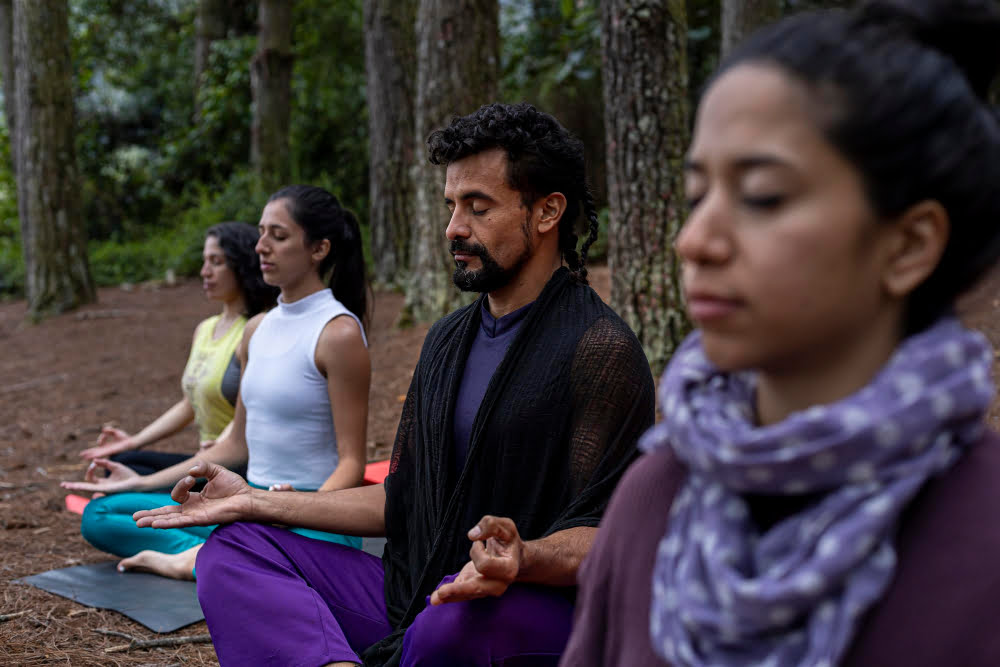Because Vedic meditation is a powerful technique that renews mental clarity, enhances creativity, and cultivates inner peace, you’ll want to continue reading to better understand this transformative practice.
Vedic meditation, derived from the ancient Vedic tradition in India, is a simple, natural, effortless technique that allows your body to settle into a state of profound rest and relaxation while your mind achieves a state of inner peace, without needing to use concentration or effort.
This form of meditation, steeped in a rich history, is renowned for reducing stress, anxiety, and fatigue, while enhancing creativity and cognitive abilities.
In the following sections, you’ll discover the origins, benefits, techniques, and tips for practicing Vedic meditation, providing a comprehensive understanding of this powerful mindfulness practice.
Key takeaways:
- Vedic meditation is a natural, effortless technique for inner peace.
- It embraces thoughts and allows the mind to naturally settle.
- Vedas provide wisdom and mantras used in Vedic meditation.
- Effortlessness is central, with no forced focus or complex postures.
- Vedic meditation releases stress and promotes relaxation.
Understanding the Concept of Vedic Meditation

At its core, this form of meditation is a simple, natural process, steeped in years of tradition and timeless wisdom. The practice involves silently repeating a specific mantra — a word or sound chosen by an experienced guide — to help settle your mind and reach a state of profound inner peace.
This meditation technique is designed to be effortless, making it accessible even to beginners. It prefers comfort and ease, requiring no complex poses, special equipment, or specific environment.
Unlike many forms of meditation where concentration and control of the mind are key, the core philosophy here embraces thought and recognizes it as part of the meditative journey. It facilitates an organic process, allowing the mind to naturally transcend busy thoughts and arrive at a place of restful awareness.
The Importance of the Veda in Vedic Meditation

The ancient Hindu scriptures known as the Vedas hold immense significance as the foundation of Vedic Meditation. Composed in Sanskrit, these texts encapsulate a wealth of wisdom encompassing philosophy, spirituality and practical living.
Across its expansive array, Vedic literature encompasses verses dedicated to harmony, health, prosperity and even scientific principles.
In meditative terms, the Vedas elaborate on strategies for mental clarity, equanimity, compassion, and self-realization. When meditating, these aspects of the Vedic teachings guide practitioners towards an exploration of their inner consciousness.
This meditation allows the mind to delve deeper beyond the surface-level noise of thoughts, bringing forth a serene mental state that the ancient texts refer to as ‘Sat-Chit-Ananda‘, meaning existence-consciousness-bliss.
Moreover, the Vedas serve as the source of the mantras used in Vedic Meditation. Each mantra— a specific sound or vibration— influences consciousness in its unique way, leading to various therapeutic effects.
These vibrations from the mantras resonate with the many layers of the individual, aligning mind, body and spirit to manifest a state of deep tranquility.
Finally, the wisdom of the Vedas empowers practitioners to maintain this calm, undisturbed perspective in their daily lives. It promotes a balanced mindset amid the noise and confusion of the physical world, encouraging a more mindful and enlightened way of life.
Experiencing Effortlessness With Vedic Meditation

In the practice of Vedic Meditation, the principle of effortlessness is central. Unlike forms of meditation that require concentration or forceful attempts to quiet the mind, this method champions a natural, relaxed approach.
1. Ease of technique: It does not involve any complex postures and can be performed sitting comfortably in any location.
2. No forced focus: The practice doesn’t call for an exerted control of thoughts. Instead, it encourages a gentle awareness.
3. Natural process: The meditator rides the waves of their own thoughts, allowing the mind to naturally settle into a state of profound stillness and rest.
4. Mantras: Personalized mantras in Vedic Meditation are designed to effortlessly draw the mind inward, away from external stimuli.
5. Stress Release: The effortless process allows the body to naturally release stress, leading to deep physiological rest.
Through embracing effortlessness, practitioners find a unique meditative state, marked by simplicity and profound rest. Each session becomes a personal journey towards stillness and tranquility.
The Practice of Vedic Meditation: A Step-By-Step Approach

Vedic Meditation, intriguingly, follows an effortless approach. Diverging from other techniques requiring focused attention, it encourages the mind to naturally settle into a state of deep tranquility. Here’s how it’s typically practiced:
1. Secure a quiet space: It’s essential to find an environment where you won’t be disturbed for the duration of your practice. A peaceful corner at your home can serve the purpose effectively.
2. Sit comfortably: Choose a position where your body is comfortable. It can be on a chair or on a meditation cushion depending upon your personal comfort.
3. Close your eyes: To start with the process, gently close your eyes. Allow your body to settle itself as you focus on natural breathing.
4. Recitation of the mantra: A personal mantra is given by your meditation teacher. This mantra is silently recited in your mind without effort. There’s no specific pace or volume required.
5. Allow your mind to wander: If your mind begins to drift away from the mantra, let it. It’s part of the process. Gently return your internal gaze back to the mantra when you realise you’ve drifted off.
6. Transition back to your day: After 20 minutes, stop repeating the mantra. Keep the eyes closed for a minute or two before gradually opening them. Transition peacefully back to your daily tasks while retaining the tranquility acquired during the meditation.
Remember, practice breeds proficiency. Over time, you’ll experience deeper levels of calm and tranquility as your meditation practice develops.
Understanding Mantra in Vedic Meditation

Mantras play a pivotal role in the practice of Vedic Meditation. Unique and personal, they are carefully chosen for each individual to ensure optimal results. Unlike random affirmations or self-created mantras, these encompass the specific vibrations needed for the practitioner.
1. Customized For the Individual: The experienced teacher selects a mantra that aligns with the meditator’s life energy. It’s an essential process, as the bonding with one’s mantra is imperative to progress.
2. Importance of Vibrations: A mantra is not just a random set of words or phrases but resonates with specific vibrational frequencies, allowing practitioners to balance their energy.
3. The Silent Usage: In Vedic meditation, the mantra is silently rehearsed in the mind, providing profound tranquility during sessions.
4. Non-Significant Meanings: Vedic mantras are not meant to have a comprehensible meaning. The vibrational essence is what’s important, not the linguistic sense.
5. Driving Out Unwanted Thoughts: Mantras also serve as an anchor, helping to distract your mind away from stress, anxiety, and mundane thoughts, creating an environment conducive to deeper meditation.
Incorporating these mantras into daily meditative practice can enhance the stability of consciousness and promote overall well-being.
How Vedic Meditation Helps in Releasing Stress

By drawing the attention inward, Vedic meditation fosters a state of profound rest, significantly deeper than ordinary relaxation, even deeper than sleep. This intense rest rejuvenates the body and mind, systematically reducing accrued stress. When the mind settles down to this state of quietness, a few interesting things start to happen:
1. Release of Stress Hormones: This practice shifts the body from a stress response to a relaxation response, resulting in a significant reduction in cortisol, often referred to as a “stress hormone”.
2. Deep Relaxation: The restful state achieved through this meditation helps defuse chronic stress and promotes deep relaxation, helping manage stress-related conditions like high blood pressure and insomnia.
3. Inner Peace: By focusing on a mantra or sound, Vedic meditation allows the mind to naturally transition towards silence, leading to increased calmness, clarity of thought, and inner peace.
4. Emotional Wellbeing: Consistent practice aids in the management of emotions, decreasing anxiety and creating a sense of harmony and balance, reducing feelings of stress and overwhelm.
5. Enhanced Mind-Body Connection: Along with stress reduction, the enhanced mind-body connection cultivated in meditation helps one better recognize stress symptoms and apply effective coping strategies.
Remember, the aim of Vedic Meditation is not to resist or suppress any thoughts, feelings, or sensations, but rather to come back to the mantra when we realize we have drifted away from it. This gentle approach aids in stress reduction and promotes a sense of calm and awareness.
Exploring the True Essence of Vedic Meditation: Peace and Happiness

Diving into the core aspects of Vedic Meditation, it primarily ignites peace and happiness. It does so by taking you on a journey beyond the realms of the physical world, where you encounter an unparalleled level of calmness.
1. Igniting Inner Peace: With regular practice, this organic method allows you to tap into the infinite reservoir of peace that resides within you. Here, you attain tranquility by peeling away stress layers.
2. Promoting Happiness: As your mind operates on a deeper level of consciousness, pent-up anxiety and depression progressively diminish. This transcendental state of being refuels positivity, driving happiness.
3. Facilitating Mental Clarity: By providing a unifying perspective, you attain an elevated level of mental clarity. It assists in better decision-making and promotes overall well-being.
4. Disentangling from Materialistic World: The practice assists you in developing detachment from material objects and daily worries, aiding in a joyful engagement with life’s experiences.
Remember, the goal here is not to escape reality but to live more fully within it. Hoisting the sails of peace and happiness, Vedic Meditation allows you to navigate life’s currents more effectively.
Benefits of Practicing Vedic Meditation

With regular practice, several transformative benefits become apparent.
1. Stress Relief: The technique aids in gently releasing accumulated stress and fatigue, promoting an enhanced state of relaxation.
2. Increased Creativity: Through quieting the mind and uniting the consciousness, it fosters an environment for creative ideas to flourish.
3. Improved Sleep: The reduction in mental chatter enables a deeper, more regenerative sleep, mitigating insomnia and sleep disturbances.
4. Enhanced Cognitive Function: The focus required can improve memory, attention span, and overall cognitive ability, leading to better problem-solving skills.
5. Emotional Well-being: It cultivates emotional balance, fostering greater self-awareness, compassion, and empathy.
6. Boosted Immunity: Reduced stress levels and balanced hormones lead to a stronger immune system.
7. Lowered Blood Pressure: The relaxation achieved lowers blood pressure, beneficial for individuals with hypertension.
Through these innate benefits, individuals find an elevated sense of fulfillment in daily life.
Mechanics and Implications of Vedic Meditation

In the realm of meditation, Vedic meditation stands out for its simplicity and efficacy. A distinctive element of this practice lies in its fundamental mechanics, employing an effortless approach as opposed to forced concentration. To provide you with a comprehensive understanding, the points below offer clarity on how it works:
1. Use of a Personal Mantra: At the heart of the Vedic meditation process is the use of a mantra. Unique to each practitioner, this ‘personal mantra’ acts as an instrumental tool, addressing the individual’s vibrational essence, which is a cornerstone of the process.
2. Constant, Effortless Repetition: The mantra is silently repeated in one’s mind throughout the entirety of the meditation session. This repetitive process accomplishes a state of deep meditation without engaging in forceful concentration.
3. Transcendental Experience: As the mantra repetition progresses, a unique phenomenon occurs. The practitioner experiences transcendence, a state where regular thought processes are operationally suspended while maintaining consciousness.
4. Natural Release of Stress: The process distinctly enables the body and mind to release stress. By commuting to calmer states of consciousness, one’s accumulated tension discretely subsides.
Now, understanding these mechanics provides a glimpse into the implications this practice entails:
1. Enhanced Cognitive Abilities: Regular practice tends to amplify various cognitive facets, including concentration, memory, and creativity.
2. Overall Health Improvement: Studies suggest that consistent practice might help lower blood pressure and anxiety levels while enhancing sleep quality and energy.
3. Cultivation of a Positive Outlook: With regular Vedic meditation practice, one often notices an increase in positivity, patience, and happiness.
Hence, Vedic meditation, steeped in its distinctive mechanics, proves to be an invaluable gift to modern life’s challenges and stressors.
Understanding the Role of a Vedic Meditation Teacher

In the journey of learning Vedic Meditation, the guidance of a knowledgeable teacher is invaluable. They’ve dedicated years to mastering and understanding the art, supplying them with experience and insights to instruct and support new learners.
1. Tailoring the Method: Every individual is unique. Therefore, teachers tailor the meditation practice to cater to personal needs and lifestyle.
2. Providing Instruction: Teachers elucidate the authentic technique of Vedic Meditation, handing down knowledge that traces back thousands of years.
3. Guiding the Journey: Experienced educators help navigate through the initial hurdles and common misconceptions associated with the practice.
4. Ensuring Correct Practice: It can be challenging to know if you’re meditating correctly. Your teacher assesses and rectifies any mistakes, ensuring progress.
5. Deepening Understanding: As you move further in your journey, the teacher provides insights into deeper meditative states, facilitating spiritual growth.
Remember, your relationship with your Vedic Meditation teacher isn’t bound by time. They continue to be a beacon of guidance, support, and knowledge as you evolve in your practice.
The Origins and History of Vedic Meditation

Delving deep into ancient Indian civilization, we discover that Vedic meditation originated over 5,000 years ago within the Vedic culture. It was first recorded in the Vedas, sacred Hindu texts, known to be one of the oldest pieces of literature in the world. This practice was initially taught orally by priests to the community to assist people in comprehending the nature of existence and achieving spiritual enlightenment.
With time, the practice later spread beyond the Indian subcontinent, reaching the far corners of the world. Notably, in the 1970s, Vedic meditation was reintroduced to the Western world by Maharishi Mahesh Yogi, who structured the practice into a meditation technique that could seamlessly fit into modern life.
There’s a common misconception that Vedic meditation is merely about mantra repetition. In reality, it seamlessly combines the use of mantras with a dedicated effort to reach a state of self-awareness, tranquility, and profound understanding, transcending the boundaries of the physical world to the realm of spirituality.
While the traditions around it have evolved over centuries, the core principle of Vedic meditation – fostering a state of deep relaxation and self-discovery – remains unchanged.
FAQ
What is the Vedic Meditation?
Vedic Meditation is an ancient technique originating from the Vedas that focuses not on contemplation or compassionate thinking, but on achieving tranquility through a unique practice.
How is Vedic Meditation different?
Vedic Meditation differs as it uses an internal system of sound, akin to thoughts, making it often more natural and easier for individuals than focusing on physical sensations like breath.
What religion is Vedic Meditation?
Vedic Meditation is a practice that originates from Hinduism.
How does Vedic Meditation impact day-to-day life?
Vedic Meditation significantly enhances day-to-day life by reducing stress, improving mental clarity, and facilitating holistic well-being.
Can beginners practice Vedic Meditation effectively?
Yes, beginners can effectively practice Vedic Meditation as it was designed to be simple, effortless and suitable for people of all ages and levels of experience.
What are some common techniques used in Vedic Meditation?
Vedic Meditation techniques commonly involve the use of a personal mantra, selected based on the individual practitioner, used in repetitive fashion to facilitate deep relaxation and stress reduction.